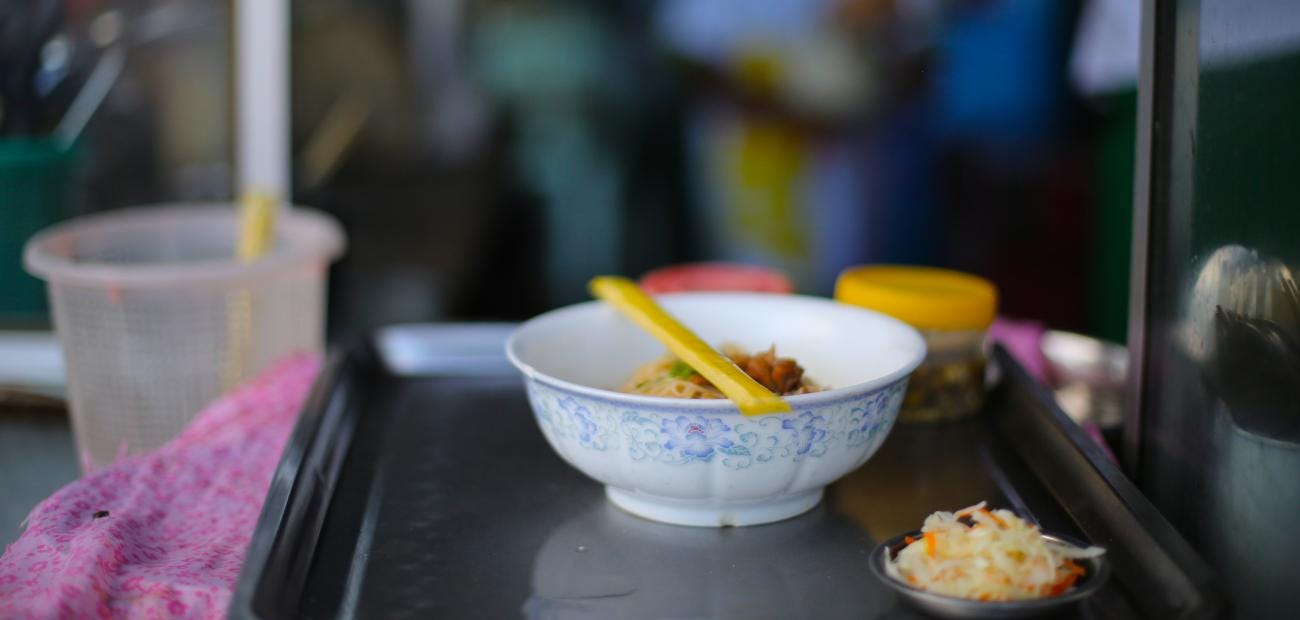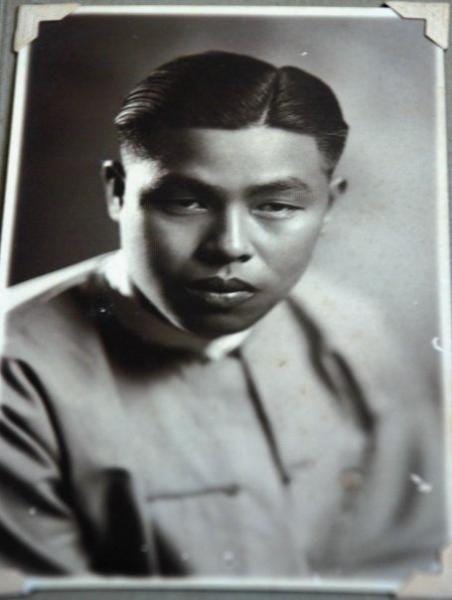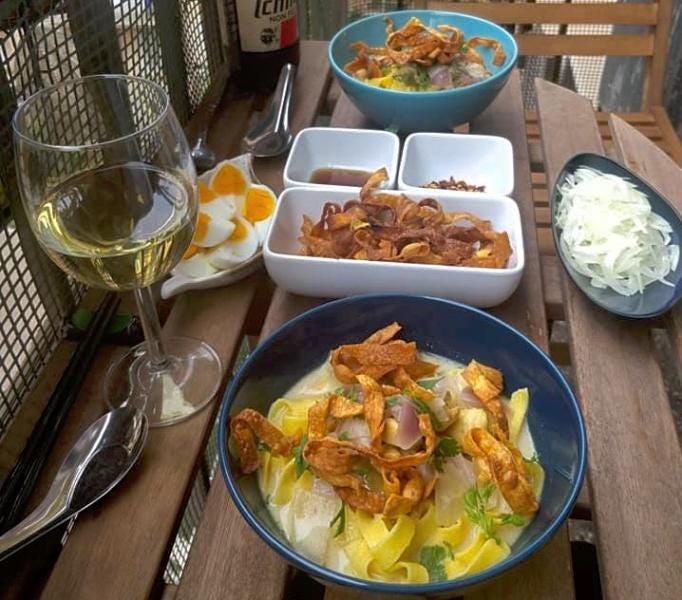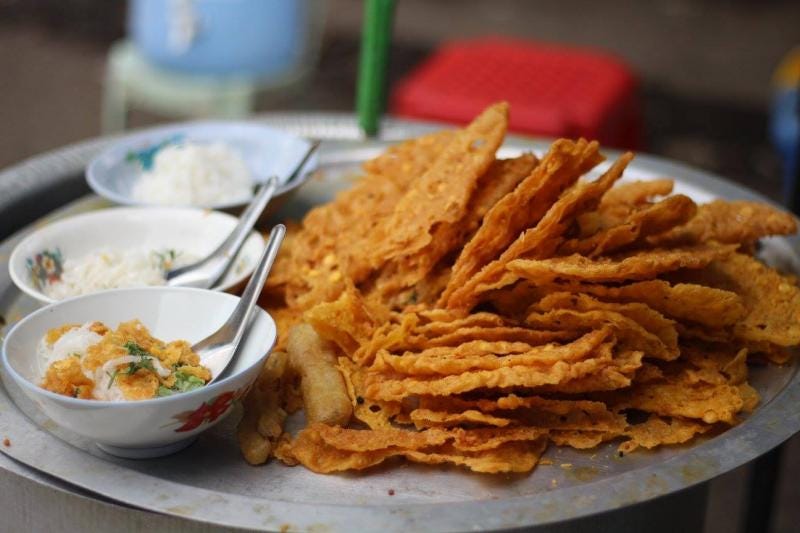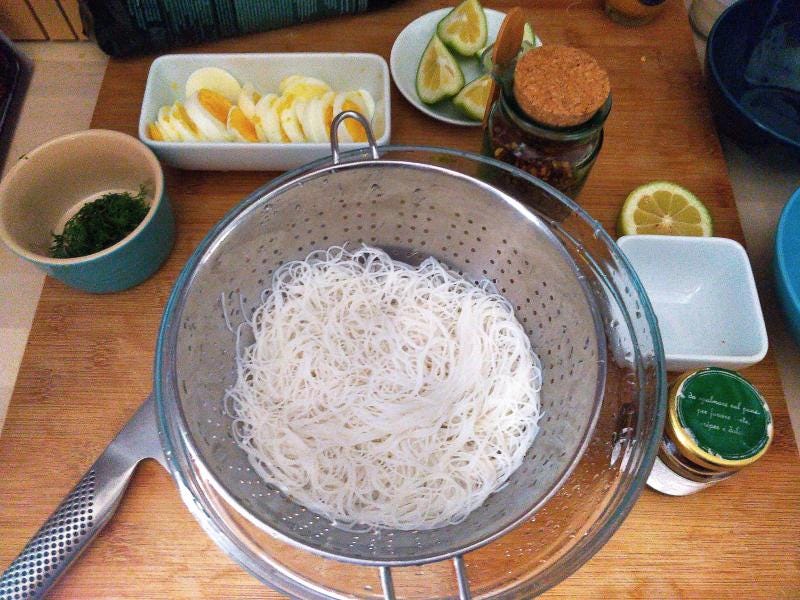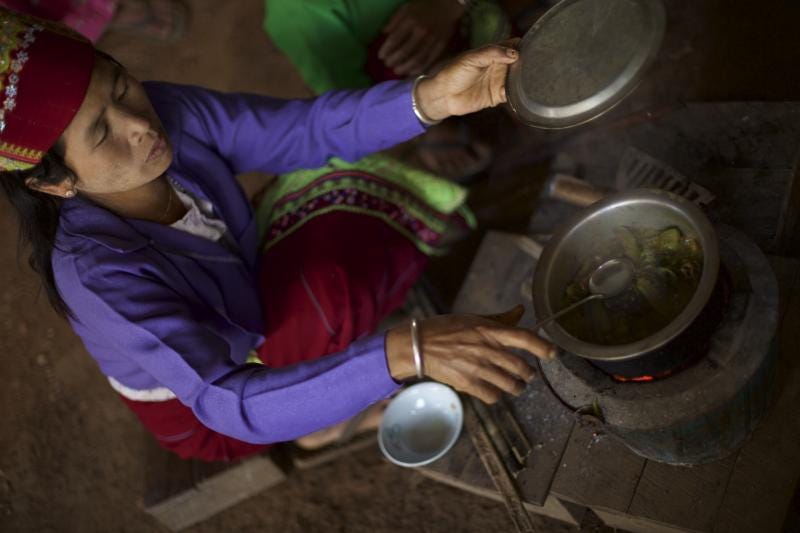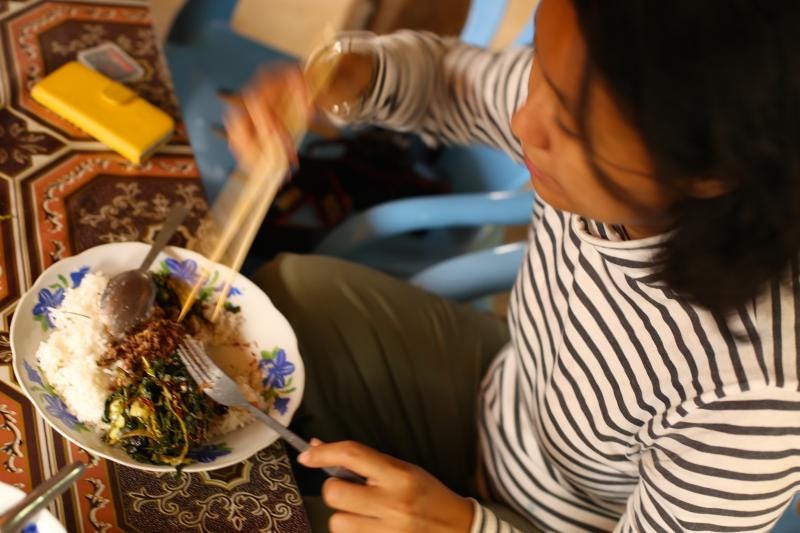Finding Home in a Bowl of Noodles
A newsletter about food systems, climate change and everything connected to them
This week, I’m republishing something I wrote late last year for The Kite Tales, a non-profit I set up with a good friend, because I now feel even more keenly the sentiments I expressed in this piece.
Of course, little did I know when I wrote this that in a few short months, my country was going to fall into an even bigger black hole and I’d find myself not knowing when - or if - I can ever go home again. This has made cooking Burmese food even more bittersweet, with a good dash of survivor’s guilt.
If you want to know how people are surviving in Myanmar, The Kite Tales continues to publish stories of ordinary people. Just this week, we featured a 22-year-old farmer and a 25-year-old from a farming family, both of whom spoke of the struggles faced by rural producers.
Oh and I’m off for the next two weeks. See you in 2022. Let’s hope it’s better than 2021. Happy holidays.
“La vita è una combinazione di magia e pasta.” - Federico Fellini
“Life is a combination of magic and pasta.”
It was a bright spring morning in Rome, but the city I saw in fragments from the windows of my apartment was hushed and sombre. I had barely left the house in weeks. Italy, the first European country engulfed by the coronavirus pandemic, had reached a disquieting milestone in its lockdown: quaranta giorni, or 40 days. The practice of ‘quarantine’ is said to have originated in 14th century Venice, where ships from ports infected with the plague were required to sit at anchor for 40 days before landing.
Seven centuries later and I was standing in our small Roman kitchen, flipping through Burmese cookbooks with a craving for something warm and familiar, something to help ease the deep concerns nibbling at the edges of my consciousness like a persistent monsoon mosquito.
I was feeling homesick, or more accurately, family-sick.
My Burmese family has been scattered across the globe for years, a legacy of the cruel and kleptocratic military government that ruled my home country until just five years ago. And we were the lucky ones. I've always been conscious of how incredibly fortunate we are to be able to study, get married, and build our lives away from the oppression inside Myanmar. But leaving has its own challenges, which have been magnified by the pandemic.
Across the other side of the Atlantic, my 80-year-old mother has been staying with my brother and his family in California, where case numbers had been climbing since late March.
In southern Spain, less than three hours by plane in normal times, my sister could not even take her children to play outside, so severe was their lockdown.
And back home in Yangon, I was acutely aware that my uncles, cousins and extended family would have to ride out the worst pandemic in a century in a country with essentially no health system.
Home.
I have been on the move since I left Burma at the age of 20. Singapore, Britain, Vietnam, Thailand. I moved back to Yangon for two years in 2015 after the country opened up, renewing my deep bond with the place where I grew up. And now this newly-created home in Rome, where I live with my Icelandic husband and where our balcony flower pots are given over to coriander plants and the hottest chili varieties we can find.
As I flicked through the pages of the cookbook my eyes caught on a recipe for “night market noodles.” The Burmese underneath said “ဆီချက်ခေါက်ဆွဲ” (si-chet khaut swe). Just reading those words took me back to childhood afternoons in Yangon, sitting in the backseat of the car on the way to pick up grandpa, my mouth watering with anticipation.
Sometimes he was at his movie production office in downtown Yangon, a cramped room piled with movie scripts and posters and a million miles from the glamour of the film sets. Other times my deeply-devout Ba Ba was at the bustling Young Men’s Buddhist Association, where he was the president until he passed away. Wherever he was, the first thing he would do when I burst through the door was to ask, “Want to eat si-chet khaut swe?”
The answer was always: “Yes!”
In a few minutes, I would be tucking into a bowl of warm noodles tossed in garlic oil and soy sauce, sprinkled with tiny pieces of crispy fried garlic, finely sliced spring onion and tender pieces of shredded chicken. While I ate, he would finish up whatever he was doing for the day. As I got older, my appetite developed and I could easily devour two bowls in one sitting.
Si-chet khaut swe is a humble dish and most corner cafes in downtown Yangon have their version. A particularly good one used to be at an unprepossessing coffee house in Yangon’s Bogyoke market, run by a proprietor with Chinese heritage named U Kywi. My mum’s childhood best friend ran a textile shop in the market and whenever she went to visit her, my sister and I would tag along and pick up U Kywi’s famous stewed duck noodles.
Just thinking about it in my kitchen in Rome, I could almost smell the herby, garlicky steam rising from the bowls.
I had never attempted to make si-chet before. But looking at the recipe on that April morning, I had no idea why; it was ridiculously easy to make. I didn’t have egg noodles but fettuccine seemed like a fine fusion option (although some might argue it’s not fusion if noodle-making originated in Asia).
Later that day, sitting across from my husband on our tiny balcony with a bowl of Italian-influenced si-chet in one hand and a pair of chopsticks in the other, I felt a sense of contentment that I hadn’t experienced in many weeks.
There’s an old Italian proverb: A tavola non si invecchia. It translates as, “At the table you do not get old” but what it means is that eating with family or loved ones is good for our health.
And that’s how I felt. It was just a bowl of noodles, but it brought back such wonderful memories.
The next day, still high from my culinary confidence boost, I attempted a much more difficult dish - aromatic and creamy coconut milk noodles (ohn-noe khaut swe အုန်းနို့ခေါက်ဆွဲ).
It took me a couple of hours but the end result was worth every minute - al-dente fettuccine noodles swimming in a thin broth of coconut milk, chickpea powder and lashings of fish sauce, topped with a mildly-spiced chicken curry and strips of crispy fried noodles.
Thus began my culinary voyage home, across continents and back through decades, as the world outside shrank to fit on our stovetop.
I was fortunate to grow up in a house where eating was associated with love, warmth and companionship, whether in a small group or with 200 people, who gathered a couple of times a year for my grandfather’s birthday or my parents’ anniversary.
On those occasions the house would begin to buzz the evening before, when I would accompany our nanny down to the cool, dark basement, past the rows of garlic, shallots and potatoes and to the cupboards at the end where we stored great stacks of plates, bowls and utensils to cater for these big events.
My sister and I usually helped our mother with desserts - her specialities were jewel-toned agar-agar (jelly) sweets topped with fluffy egg whites or milky-white ones flavoured with coconut milk. I was a strong but clumsy kid, so my duty was to sit on the floor, hug the bowl of egg whites and whisk furiously until they became stiff and could be piled on the sweets like Himalayan peaks. Yes it was a lot of work and no, we didn’t have any electrical baking equipment.
By the day of the feast our large living room had been transformed. The furniture had been moved out onto the balcony, the parquet floor was covered in multiple rugs, and round wooden tables were arranged across the room. The guests would come in waves throughout the morning and sometimes well into the afternoon, clustering round the low tables as part of what was usually a very long lunch.
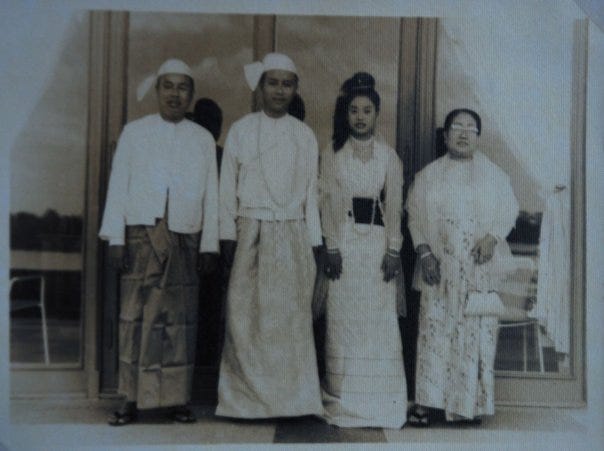
I have to admit that for many years, my interest was more in the eating than the cooking of the food we had at home.
Unlike my sister, I’m not a natural in the kitchen and there were so many great cooks around me. My aunty in Singapore, whose food I still dream about, took pity on me when I lived with her and told me to concentrate on my studies instead of coming into the kitchen.
I learnt to cook only in my mid-20s when I was studying for my Masters in southwest England because I was living alone for the first time. Friends in Singapore had given me the nickname PBR (Powered By Rice) and it soon dawned on me that I couldn’t survive on sandwiches and baked potatoes alone. This was in the early 2000s and Bournemouth wasn’t known as a bastion of international cuisine. Besides, as a student, I was skint and I realised that buying bone-in chicken with skin would not only stretch my weekly budget further but also make a tastier meal.
Ultimately, I discovered I enjoy cooking. I find it calms me down and keeps me focused. And I love feeding people because it reminds me of our old house in Yangon and of those happy, festive celebrations, with the smell of curries and rice cooking and gaggles of guests coming and going.
Food is a huge part of my life. I moved to Rome to report on issues around agriculture, hunger and climate - topics very close to my heart - and of course Italy is a nation of food lovers. Here eating is synonymous with family, identity and history and is the solution to most problems.
During Italy’s lockdown, as I physically shared Burmese meals with my husband - and virtually with family through WhatsApp and Facebook chats - I relived moments from my childhood that gave me a reassuring sense of connection with the passage of time, in the weeks where days melted into each other.
I was helped on my way by the authors of two of my favourite Burmese cookbooks - Tin Cho Chaw who wrote hsa*ba and MiMi Aye who wrote Mandalay - as well as my sister, one of the best Burmese home cooks I know, who was always just a WhatsApp message away with encouragement and suggestions for substitutions.
We tried arr-loo-kat-tha-lik အာလူးကတ်သလစ် - potatoes boiled, mashed and then stuffed with spiced minced meat before being rolled in flour and egg and fried - which my nanny used to make all the time.
Then I made salty, spicy nga-pi-chet ငါးပိချက်, which my dad loved and would cook from time to time, but in place of the pungent Burmese salted fish I used copious amounts of anchovies for that umami flavour.
My sister gave me her recipe for pork curry with generous dollops of mango chutney ဝက်သားသရက်သီးသနပ် for the days when we wanted something spicy. She also taught me to shred chayote, a type of gourd, slice wafer-thin layers of fried eggs, sauté prawns and stew chickens to make many of the salty and sour salads that graced our lazy Susan at almost every meal in Yangon.
After several months, I finally plucked up the courage to attempt the quintessential breakfast dish across many parts of Myanmar: fragrant mont-hin-gar မု့န်ဟင်းခါး, fish noodle soup.
I had always put off making many of these dishes - they were too complicated, sometimes taking half a day or longer to cook, and requiring ingredients that were too difficult to find abroad.
But perhaps the biggest thing that had held me back was my perfectionist streak. While I would happily try my hand at making complicated Mediterranean stews, Indian curries and British-style Sunday roasts, I’d always shied away from going beyond a handful of salads and simple curries from my own childhood. They would never be as good as the versions I had eaten at home. They would never be “authentic”.
Well, I have no illusions about the authenticity of my recent Burmese culinary attempts.
My mont-hin-gar didn’t have fishcakes, banana stems or most importantly, catfish, the main ingredient. I couldn’t find any of them in Rome. So I followed MiMi’s advice and used a mixture of tinned mackerel and sardines. I made my own rice flour for the soup and even self-raising flour for the crunchy split pea fritters - a traditional accompaniment to mont-hin-gar. All in it took over four hours to bring the dish together, excluding the overnight soaking of the split peas.
I may have had to compromise on ingredients and my fritters may not have been quite as crisp as I would have liked, but in the end I didn’t mind at all, because just in the act of making and eating these dishes I felt closer to my family. Besides, it was still comfort in a bowl - thick, peppery, mustard-coloured broth fragrant with lemongrass, thickened with chunks of fish and sweetened with onions that fell apart when touched.
Even cooking something new could conjure memories of childhood - of tagging along on my grandfather's weekly wet market runs where he would chat to butchers and grocers he had known for years. Of my mother making ham for my father in a small, grey potbellied oven that looked like an apparatus on a spaceship, which she would gingerly slide under a side table in the dining room. The oven would be on overnight and sometimes well into the next day. Every time I walked past it, I would breathe in deeply, taking in the delicious aroma of sizzling pork fat mixed with dozens of cloves.
When I baked for the first time in more than two decades - banana bread to use up fruit bought in a moment of health consciousness and then ignored - I remembered learning how to make butter cookies at the government culinary school in Yangon where my sister and I spent a high school summer.
But the lockdown culinary trips also took me beyond the belly of my childhood.
It was also a way to relive the year I spent travelling around Myanmar collecting stories for the Kite Tales project with fellow journalist Kelly Macnamara. These days when I taste Sichuan peppers, I think of our trip to Naga in 2016 - discovering the rich and fiery cuisine of this mountainous region on the western border with India. If a recipe mentions rice wine, my mind skips back to earthenware bowls of the warm, frothy, and slightly tart liquid we enjoyed all over verdant Kayah State in Myanmar’s east. Even making spaghetti alle vongole reminded me of the seafood feast Kelly and I had while travelling in Tanintharyi, the long tail of Myanmar.
That year helped me learn so much about my own country besides fulfilling our wish to show a different face of a nation that has suffered so much stereotyping.
But it wasn’t until I found myself unable even to venture beyond our neighbourhood supermarket that I realised how much the experience had nourished me too, giving me an understanding of self, identity, belonging and home.
These strange and difficult times have made me very aware of my good fortune. I still have a job and my loved ones are far away but in good health. I can at least hear and see them on my phone.
Still, it is unlikely that my family members will ever settle in the same country. And I don’t know when or if I will live in Myanmar again. I don’t know how many more times I’ll get to see my elderly nanny in Yangon, my cousin from Shan State and our beloved cook who feeds me endlessly whenever I go back. And I cannot return to my troubled country to witness only the second election in my lifetime, which is scheduled to take place next month.
So I will continue to make food from home, imperfect as my renditions sometimes are. Because with each meal, I know the people - and the country - I love live within me. I keep reminding myself of that whenever I feel unmoored.
Rome, October 2020
As always, have a great weekend! Please feel free to share this post and send tips and thoughts on twitter @thinink, to my LinkedIn page or via e-mail thin@thin-ink.net.


